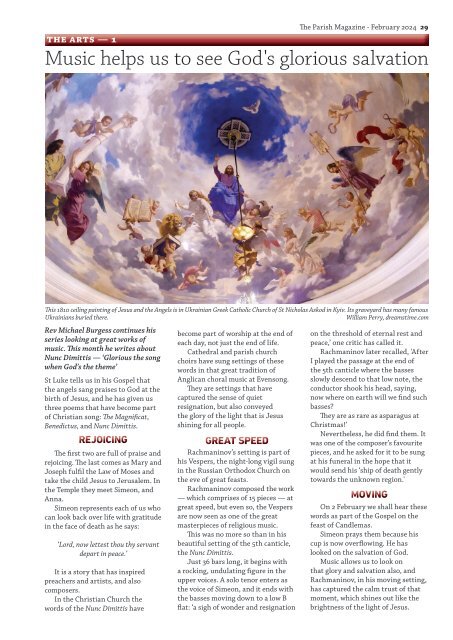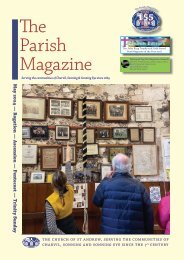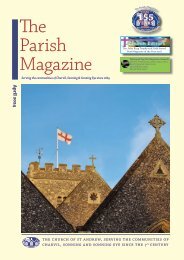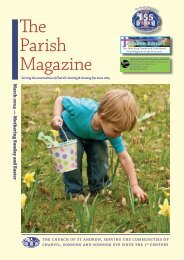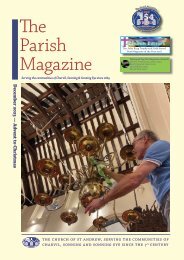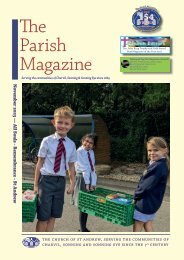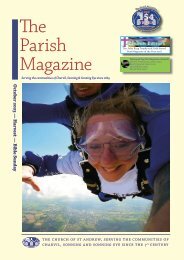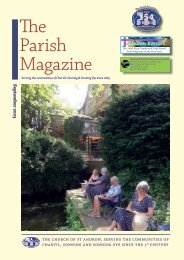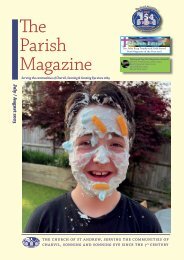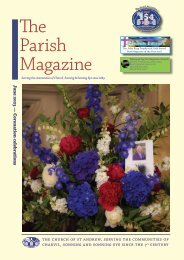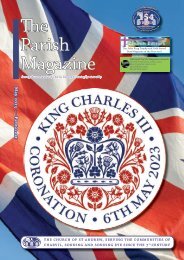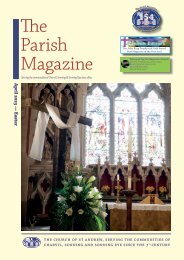The Parish Magazine February 2024
Serving the communities of Charvil, Sonning and Sonning Eye since 1869
Serving the communities of Charvil, Sonning and Sonning Eye since 1869
Create successful ePaper yourself
Turn your PDF publications into a flip-book with our unique Google optimized e-Paper software.
THE ARTS — 1<br />
<strong>The</strong> <strong>Parish</strong> <strong>Magazine</strong> - <strong>February</strong> <strong>2024</strong> 29<br />
Music helps us to see God's glorious salvation<br />
Rev Michael Burgess continues his<br />
series looking at great works of<br />
music. This month he writes about<br />
Nunc Dimittis — ‘Glorious the song<br />
when God’s the theme’<br />
St Luke tells us in his Gospel that<br />
the angels sang praises to God at the<br />
birth of Jesus, and he has given us<br />
three poems that have become part<br />
of Christian song: <strong>The</strong> Magnificat,<br />
Benedictus, and Nunc Dimittis.<br />
REJOICING<br />
<strong>The</strong> first two are full of praise and<br />
rejoicing. <strong>The</strong> last comes as Mary and<br />
Joseph fulfil the Law of Moses and<br />
take the child Jesus to Jerusalem. In<br />
the Temple they meet Simeon, and<br />
Anna.<br />
Simeon represents each of us who<br />
can look back over life with gratitude<br />
in the face of death as he says:<br />
‘Lord, now lettest thou thy servant<br />
depart in peace.’<br />
It is a story that has inspired<br />
preachers and artists, and also<br />
composers.<br />
In the Christian Church the<br />
words of the Nunc Dimittis have<br />
become part of worship at the end of<br />
each day, not just the end of life.<br />
Cathedral and parish church<br />
choirs have sung settings of these<br />
words in that great tradition of<br />
Anglican choral music at Evensong.<br />
<strong>The</strong>y are settings that have<br />
captured the sense of quiet<br />
resignation, but also conveyed<br />
the glory of the light that is Jesus<br />
shining for all people.<br />
GREAT SPEED<br />
Rachmaninov’s setting is part of<br />
his Vespers, the night-long vigil sung<br />
in the Russian Orthodox Church on<br />
the eve of great feasts.<br />
Rachmaninov composed the work<br />
— which comprises of 15 pieces — at<br />
great speed, but even so, the Vespers<br />
are now seen as one of the great<br />
masterpieces of religious music.<br />
This was no more so than in his<br />
beautiful setting of the 5th canticle,<br />
the Nunc Dimittis.<br />
Just 36 bars long, it begins with<br />
a rocking, undulating figure in the<br />
upper voices. A solo tenor enters as<br />
the voice of Simeon, and it ends with<br />
the basses moving down to a low B<br />
flat: ‘a sigh of wonder and resignation<br />
Jesus Angels Painting Ceiling<br />
Interior Church Saint Nicholas<br />
Askold s Grave Kiev Ukraine.<br />
Ukrainian Greek Catholic Church<br />
created 1810. Askold s Graveyard<br />
has many famous Ukrainians<br />
buried there.<br />
This 1810 ceiling painting of Jesus and the Angels is in Ukrainian Greek Catholic Church of St Nicholas Askod in Kyiv. Its graveyard has many famous<br />
Ukrainians buried there.<br />
William Perry, dreamstime.com<br />
on the threshold of eternal rest and<br />
peace,’ one critic has called it.<br />
Rachmaninov later recalled, 'After<br />
I played the passage at the end of<br />
the 5th canticle where the basses<br />
slowly descend to that low note, the<br />
conductor shook his head, saying,<br />
now where on earth will we find such<br />
basses?<br />
<strong>The</strong>y are as rare as asparagus at<br />
Christmas!’<br />
Nevertheless, he did find them. It<br />
was one of the composer’s favourite<br />
pieces, and he asked for it to be sung<br />
at his funeral in the hope that it<br />
would send his ‘ship of death gently<br />
towards the unknown region.'<br />
MOVING<br />
On 2 <strong>February</strong> we shall hear these<br />
words as part of the Gospel on the<br />
feast of Candlemas.<br />
Simeon prays them because his<br />
cup is now overflowing. He has<br />
looked on the salvation of God.<br />
Music allows us to look on<br />
that glory and salvation also, and<br />
Rachmaninov, in his moving setting,<br />
has captured the calm trust of that<br />
moment, which shines out like the<br />
brightness of the light of Jesus.


